There are a ton of abilities and mechanics in Magic: the Gathering. Luckily, you don’t need to master them all to play. However, there are a few abilities that are so common and integral to the game that learning them is basically mandatory. Today we’re going to go over one such ability: Lifelink.
Lifelink is one of the most common and useful abilities in the entire game. Whenever a source with lifelink deals damage, the controller of the source gains life equal to the amount of damage dealt.
The idea behind the ability is pretty simple. Like most things in Magic: The Gathering, however, it has the potential to get quite complicated. Not to worry. In this article, I’ll answer any questions you may have about lifelink I’ll also give my picks for the best cards in the game today!
Table of Contents
- What Is Lifelink?
- How Does It Work?
- FAQs
- How to Beat a Life Gain Deck
- Best Cards
- Best Commanders
- End Step
What Is It?
Lifelink is a keyword ability in Magic: The Gathering that is mostly found on creatures. Whenever a creature with the ability deals damage, its controller gains life equal to the amount of damage dealt. Here are the official rules text from Wizard’s of the Coast:
“Damage dealt by a source with lifelink causes that source’s controller, or its owner if it has no controller, to gain that much life (in addition to any other results that damage causes).”
Comprehensive Rules: 702.15b
How Does It Work?
For the most part, lifelink is pretty simple. Let’s say I have a lifelink creature like Child of Night on the battlefield. I attack my opponent who doesn’t declare any blockers. Child of Night deals two damage to my opponent, and I gain two life.
The damage doesn’t have to be dealt to an opponent for lifelink to work, however. Let’s say my opponent has a 1/1 creature, and uses it to block my Child of Night. In that case, Child of Night deals two damage to their 1/1 creature, and I gain two life.
What about planeswalkers? Let’s say my opponent has Liliana of the Veil and I choose to attack Lilly with my Child of Night. Child of Night deals two damage to Lilly, and I gain two life. Pretty simple, right?
Lifelink works any time a source with lifelink deals damage to anything. This includes when blocking, or from effects from cards like Devouring Tendrils.
FAQs
Does It Work For Defending?
Yes, lifelink works when defending. If you use a lifelink creature to block, that creature deals damage equal to its power to the attacking creature. You then gain that much life.
RELATED: MTG Deathtouch: How It Works And What It Does
Do You Get Lifelink When Blocking?
Yes, you gain life from lifelink when you block! Whenever you block, your creature deals damage equal to its power to the creature it’s blocking. You then gain life equal to that damage. You gain this life regardless of the outcome of combat.
Does Lifelink Work When a Creature Dies?
This depends on why the creature is dying. If you deal damage with a lifelink creature, you gain life equal to the damage regardless of the final outcome of combat. If you attack with a 2/2 lifelink creature, and your opponent blocks with a 4/4 creature, your creature will die at the end of combat. Before that, however, your creature still deals two damage to the blocking creature and you still gain two life.
On the other hand, if a creature dies before it can deal damage, its controller will not gain any life. This is usually the result of a removal spell. So for example, if you attack or block with a lifelink creature, and your opponent casts Murder targeting your creature before combat damage, then you don’t have a chance to gain any life.
Any time a lifelink creature deals damage, its controller gains life, regardless of anything else. Attacking and blocking, and actual damage, however, happen at separate times. So attacking or blocking doesn’t automatically mean you’ll gain life. The creature does need to survive until the combat damage step.
RELATED: Dominaria United – Everything We Know So Far
When Does It Trigger?
Lifelink doesn’t technically “trigger”. Instead, the life-gain simply occurs simultaneously whenever damage is dealt.
Does It Trigger Before or After Damage?
Lifelink “triggers” at the exact same time damage is dealt. This means that players gain life regardless of what happens as a result of combat damage. It also means that life gained from the ability can save a player from an otherwise lethal attack.
Can Lifelink Stop You From Dying From Combat Damage?
Yes, lifelink can stop you from dying from combat damage! Let’s use a simple example.
I have just one life remaining. I also have a 1/1 lifelink creature. My opponent attacks me with two 1/1 creatures. I can block one of the attacking creatures, but not both. Since I only have one life left, the remaining unblocked attacker should be enough to kill me. But I can gain one life from blocking with my lifelink creature!
Will I take the damage from the one unblocked creature and die before I have a chance to gain that life though? Or do I gain the one life from my creature before I take the lethal damage?
Let me explain how it works.
I gain life from lifelink at the same exact time that combat damage is dealt to me. Damage is dealt and life is gained all at once and then afterwards, if my remaining life total is more than zero, I survive. Think of it like a math equation.
So for this particular equation, we start at one (my starting life total) and we subtract any damage that we’re being dealt (1), and add any life that we’re gaining from lifelink (1). 1-1+1 = 1. And then, once that’s all said and done, we check to see if we have any life remaining. In this scenario, we do. And so we survive for at least another turn. Yay!
How to Beat a Life Gain Deck?
There are a few different strategies you can employ against decks that use life gain. These strategies will vary depending on the format and the deck you’re using.
Method 1: Using Lifegain Prevention
One of the best ways to deal with annoying life gain, is simply to prevent it. There are several cards like Skullcrack, Erebos, God of the Dead, and Leyline of Punishment that are great at this. And then you have Rain of Gore that actually makes your opponent lose any life that they would gain!
WARNING: You have to be really careful with this method. Cards like these usually make your deck a lot worse any time you play against an opponent that doesn’t use lifegain. I would recommend adding these to your sideboard instead of your main deck, and only if your deck really struggles against life gain.
Method 2: Using Removal/Counterspells
This is a more general strategy and one that you can use without weakening your own deck. Removal, boardwipes in particular, is perfect for getting rid of annoying lifelink creatures. Spot removal, such as Murder is also a good option to take out big life gain threats.
If you’re playing a burn or aggro deck, it’s important to remember to use your burn spells on creatures. Before you decide to hit your opponent in the face with your last Lightning Bolt, you might want to consider saving it if you know a lifelinker might be coming. And once a creature that can gain life does hit the battlefield, you should take it out immediately. Don’t give your opponent the opportunity to gain any life.
Method 3: Commander Damage
If you’re playing EDH, one of the best ways to counter life gain is to deal Commander damage. Your opponent’s life total can be at 300 or 3000 or three million. It doesn’t matter. You still only have to deal them 21 damage with your commander to take them out of the game!
Related: Commander Damage: How It Works
Best Lifelink Cards
Nighthawk Scavenger
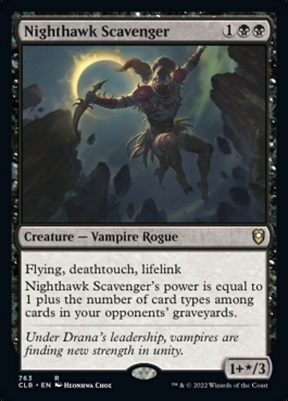
Nighthawk Scavenger is an upgraded version of Vampire Nighthawk, an already great lifelinker. It’s pretty common for your opponent(s) to have at least two card types in their graveyard, making Nighthawk Scavenger a three mana 3/3 with flying, deathtouch, and lifelink!
And the ceiling for Nighthawk Scavenger is much higher than that. In many games, especially in Commander, Nighthawk can easily grow into a 5/3 or even a 6/3! That much power combined with lifelink makes for some serious swings.
Wurmcoil Engine

It’s hard to find a card packed with more value than Wurmcoil Engine. For six mana you get a 6/6 artifact wurm with deathtouch and lifelink. And when/if it dies, you get to create a 3/3 token with deathtouch, and a 3/3 token with lifelink.
Wurmcoil Engine basically just splits in half instead of dying, making it a huge pain to deal with. Assuming you can’t exile it, you either have to burn three different removal spells, trade two different creatures to block the deathtouchers, take a lot of damage from lifelinkers, or some combination of all of the above. Wurmcoil Engine is not a lot of fun to deal with. As always, however, if it’s on your side it’s a blast.
Archangel of Thune
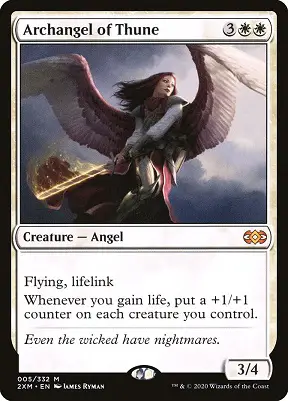
Archangel of Thune is perhaps the best of all the many powerful five mana Angels.
Archangel of Thune has powerful stats, and she lets you put a +1/+1 counter on each creature you control every single time you gain life! This can be devastating in the right deck.
Archangel of Thune sees a ton of casual play in Angel tribal decks in Modern and Commander. It also sees a good bit of competitive play in Modern where it combos infinitely with Spike Feeder.
Serra Ascendant
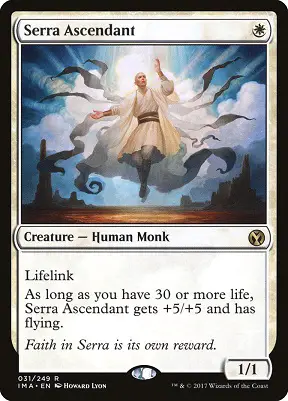
Serra Ascendant is an absolute powerhouse in life gain decks. Even in modern, gaining 10 life over the course of a game isn’t as hard as one might think.
Serra Ascendant really shines in Magic’s most popular format, however. In Commander, you start the game with 40 life, meaning Serra Ascendant‘s condition is automatically met. A 6/6 flying lifelinker on the first turn of the game! Unfair for your opponents? Maybe. Awesome for you? Definitely.
Griselbrand
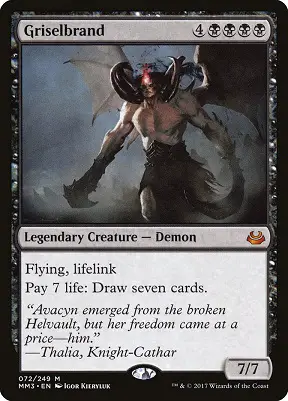
Griselbrand is one of the most fearsome, terrifying, brutal, powerful, insane (okay I’m out of adjectives) creatures in all of Magic.
For eight mana, you get a 7/7 Demon with flying and lifelink. Griselbrand’s real power, however, comes from his activated ability. In exchange for seven life, Griselbrand lets you draw seven cards! You can activate this ability immediately, and you can do it as many times as you want.
Griselbrand is so powerful that he’s banned in Commander. Nowadays he sees the most play in Modern and Legacy.
The most potent Griselbrand decks aim to cheat Griselbrand into play using cards like Goryo’s Vengeance or Neoform and Allosaurus Rider. Then once on the battlefield, Griselbrand lets you wreak havoc by drawing a ton of cards and setting yourself up for all sorts of combo wins.
These Griselbrand decks have taken a big hit recently with the banning of Faithless Looting and Simian Spirit Guide. They’re still around though, and Griselbrand is still as frightening as ever when he hits the battlefield.
Best Commanders
Vito, Thorn of the Dusk Rose
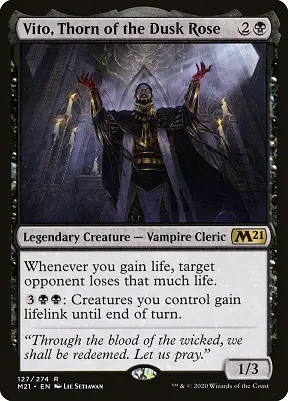
Vito, Thorn of the Dusk Rose is a three mana 1/3 with a powerful activated ability, and a game-ending static ability!
For five mana, he gives all of your creatures lifelink until the end of turn. His static ability, however, is the real game changer. Anytime you gain life, your opponents lose that much life. For a life-gain deck, this is really good just throughout the regular course of the game.
All it take is one other card, however, to turn “really good” into game over.
I’m talking about Exquisite Blood of course. Any time your opponents lose life, Exquisite Blood gains you that much life. Combine that with Vito, Thorn of the Dusk Rose, and you have a combo that immediately drains all of your opponents’ life.
Liesa, Shroud of Dusk
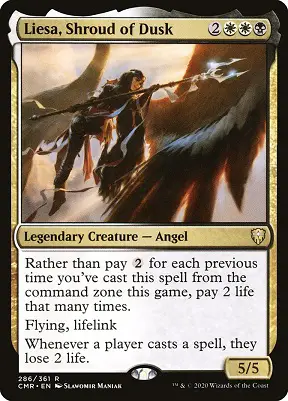
Liesa, Shroud of Dusk is ridiculous. For five mana, you get a 5/5 flying Angel with Lifelink and two powerful abilities.
First off, Liesa lets you pay commander tax with life instead of mana! This means you can cast her over and over again from the command zone just by using the extra life you’ve built up.
Then, she makes every player lose two life any time they cast a spell! Yes, that does include you. But, you’re playing a life-gain deck. You can afford to lose two life every time you cast a spell. Your opponents, however, probably can’t.
End Step
The lifelink ability is one of the most common and powerful mechanics in all of MTG. No matter what format you’re playing, you’re sure to end up playing with and against lifelink at some point.
I hope this article has answered all of your questions. If not, drop a comment below and I’ll be happy to respond.
